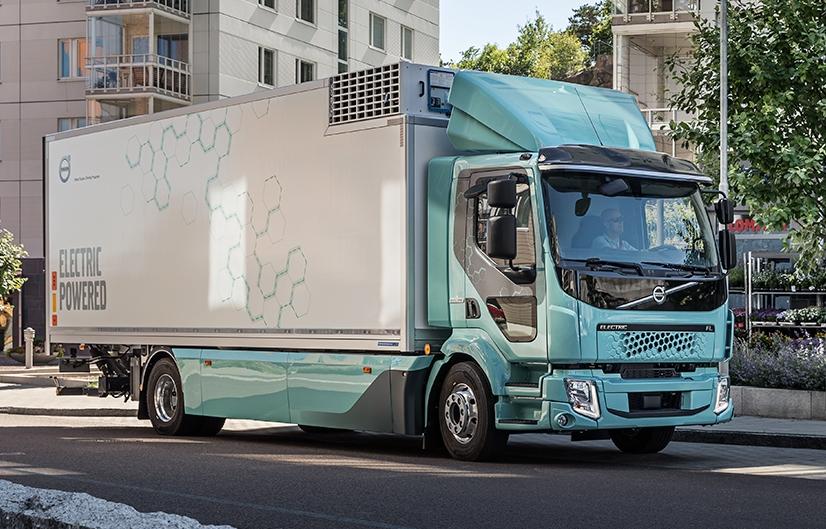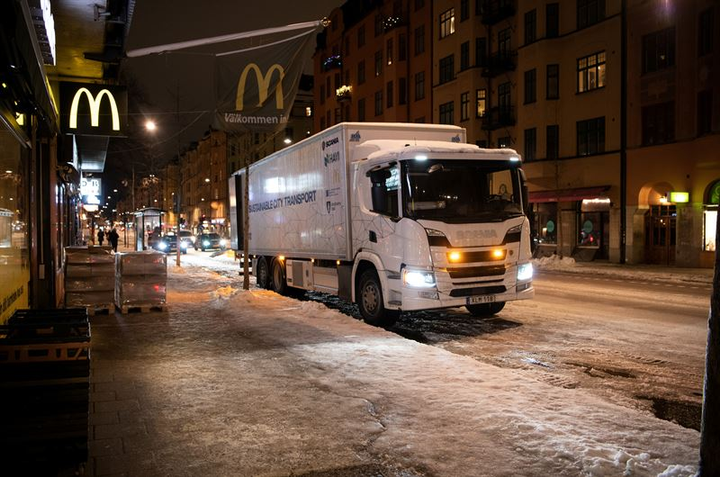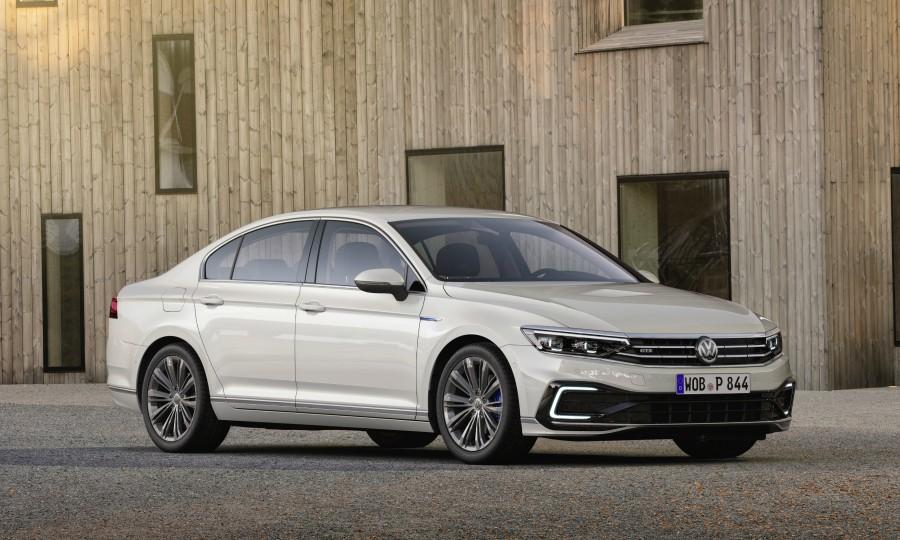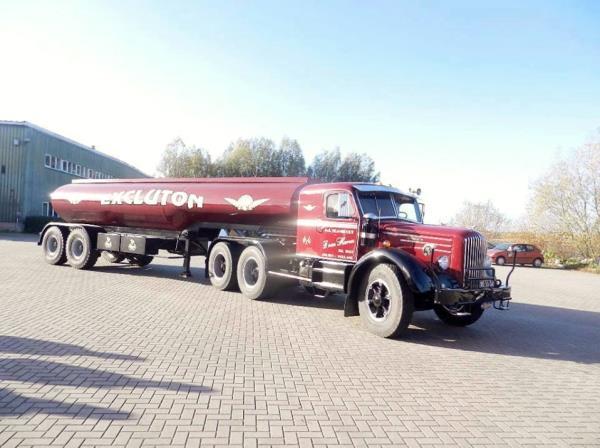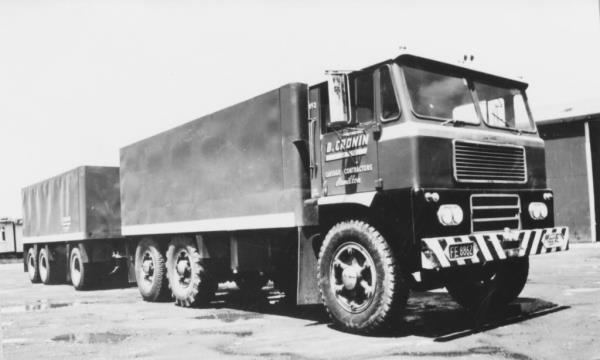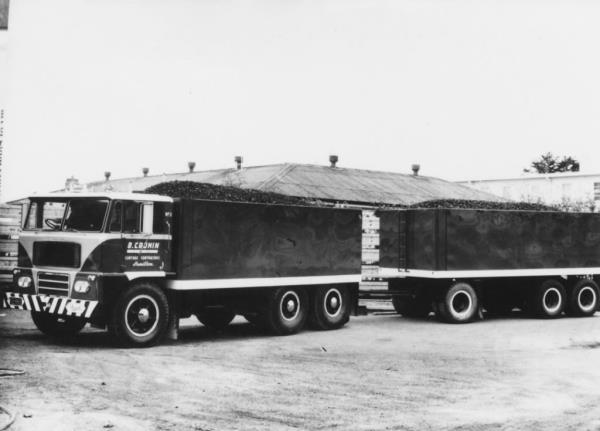
kscarbel2
Moderator-
Posts
18,868 -
Joined
-
Days Won
114
Content Type
Profiles
Forums
Gallery
Events
Blogs
BMT Wiki
Collections
Store
Everything posted by kscarbel2
-
EU countries agree to 30 percent cut in truck CO2 emissions
kscarbel2 replied to kscarbel2's topic in Trucking News
European Truckmakers Fight New EU Emissions Regulations David Cullen, Heavy Duty Trucking (HDT) / February 20, 2019 Member states of the European Union and the EU Parliament reached a tentative deal on February 19 to establish tight carbon-dioxide emission limits for heavy-duty commercial vehicles. The two-tiered compromise agreement still needs to be endorsed by member states and the European Parliament, but those actions are regarded as formalities. The rules will require that between 2025 and 2029 new trucks must emit on average 15% less CO2, compared to 2019 truck emission levels. Then starting in 2030, they will be required to emit on average 30% less CO2 than in 2019. “Those targets are binding, and truck manufacturers which do not comply will have to pay a financial penalty in the form of an excess emissions premium,” the EU stated in a press release. On the other hand, making the new rule something of a carrot-and-stick deal, the EU also said it was “strengthening” incentives for OEMs to build low- and zero-emission trucks. In addition, the EU has established “specific measures” to ensure “robust and reliable data” on emissions, which will be obtained through onboard devices that “monitor the actual fuel and energy consumption of heavy-duty vehicles.” In December, the EU placed such CO2 standards on cars and light vans. The truck limits are another step in the 28-nation bloc’s stated plan to fight global warming by slashing greenhouse gas emissions to a “net zero” level by 2050. An EU statement described the deal as “a further stepping stone for modernizing he European mobility sector and preparing it for climate neutrality in the second half of the century.” “With the first-ever EU emission standards for trucks agreed, we are completing the legal framework to reach the European target of cutting greenhouse gas emissions by at least 40% by 2030,” commented EU Commissioner for Climate Action and Energy Miguel Arias Cañete. “The new targets and incentives will help tackle emissions, as well as bring fuel savings to transport operators and cleaner air for all Europeans. For the EU industry, this is an opportunity to embrace innovation towards zero-emission mobility and further strengthen its global leadership in clean vehicles.” No sooner than the rules were announced, the European Automobile Manufacturers’ Association (ACEA) declared that it was “most particularly concerned about the highly ambitious CO2 reduction targets” set for trucks. “These targets are highly demanding, especially as their implementation does not depend solely on the commercial vehicle industry, and the baseline for the targets is still unknown.” The truck OEM members of ACEA are DAF Trucks, Daimler Trucks, Iveco, MAN Truck & Bus, Scania, Volkswagen Commercial Vehicles, and Volvo Group. ACEA’s main concern is a lack of infrastructure to fuel or charge the alternatively powered trucks that may need to be built to meet the CO2 limits. To that point, the association stated that "data shows that currently there is no public charging or refueling infrastructure suitable for electric or hydrogen trucks whatsoever. Even in the case of truck-specific filling stations for natural gas (CNG and LNG), availability remains very low and patchy across Europe.” In addition, ACEA argues that the need for the 28 EU member states “to implement an EU-wide infrastructure action plan is all the more urgent in light of the mandatory sales quotas for zero-emission trucks that the EU institutions have agreed to introduce from 2025 onwards.” “We can now only call upon [EU] member states to urgently step up their efforts to roll out the infrastructure required for charging and refuelling the alternatively powered trucks which will need to be sold en masse if these targets are to be met,” said ACEA Secretary General Erik Jonnaert in a statement. Jonnaert added that truck operators cannot be expected to ““suddenly start buying electric or other alternatively powered trucks if there is no business case for them and it is not possible to easily charge the vehicles along all major EU motorways. Policy makers must act to ensure that the zero-emission trucks that manufacturers will be mandated to produce can actually be bought and operated by our customers.” -
Transport Topics / February 20, 2019 Volvo Trucks delivered its first all-electric vehicles to two companies operating in Sweden. A refuse truck went to waste and recycling company Renova, and a distribution truck to logistics company DB Schenker and partner hauler TGM. Series production of a limited number of FL electric trucks, as well as heavier FE electric trucks, for the European market is slated to begin in the second half of the year. The absence of motor noise and exhaust emissions in test drives is seen as contributing to better working conditions for the drivers and a quieter, cleaner urban environment. The Volvo FL Electric and Volvo FE electric trucks are developed for urban transport applications including distribution and refuse handling. The Volvo FL electric has a gross vehicle weight of 35,274 pounds, while the Volvo FE electric has capacity for a GVW of 59,524 pounds. “Our close collaboration with drivers and customers has enabled us to develop, in a short space of time, electrified transport solutions that meet high requirements in terms of performance, driving distances, cargo handling and vehicle use,” Volvo Trucks President Roger Alm said in a release Feb. 19. At the same time, Volvo Trucks is “steadily reducing the environmental and climate impact of our diesel- and gas-powered trucks, primarily through energy-efficient drivelines,” Alm said. Volvo Trucks, whose North American units include Mack Trucks and Volvo Trucks North America, is a unit of Gothenburg, Sweden-based Volvo Group. .
-
The impression I get is it is no longer culturally correct to set the benchmarks that have historically pushed students to reach their full potential. Our generations grew up realizing again and again that what we thought at first was impossible (or too hard)........is possible. Pushing the envelope, for us, was part of growing up. What's wrong with healthy competition? Poor letter grades embarrass one to apply themselves more........and there's no harm in that, in preparing for the real world.
-
.
-
Most schools are getting rid of the class ranking system for graduating seniors. In the policy, numerical class ranks will no longer be calculated and there won't be valedictorians or salutatorians. Rather than raising the bar for our students, they are lowering it. Everybody’s a winner……even when they didn’t study hard and aren’t.
-
Ford Brazil in better times. ---------------------------------------------------------------------------------- Ford announces 6 new truck models and production of the 400,000th Cargo in Brazil June 16, 2015 .
-
Ford to cut products, jobs in South American shakeup Michael Martinez, Automotive News / February 19, 2019 Ford is ending production of a number of vehicles at its Sao Bernardo do Campo plant in Brazil and cut a "significant" amount of workers there as it attempts to save its floundering South American operations. Ford said Tuesday it will exit the commercial heavy-duty truck business in South America after it stops building its Cargo commercial truck lineup at the Brazil plant this year. Ford will also end production and sales of the F-4000 and F-350 pickups and Fiesta subcompact sedan in South America. The actions will result in a $460 million charge that will mostly be recorded in 2019, according to a filing with the Securities and Exchange Commission. About $360 million of that will be for "separation and termination payments for employees, dealers, and suppliers," according to the filing. The Brazil plant employs nearly 2,800 workers. It's unclear if the facility will close or receive new products. "Ford is committed to the South American region by building a sustainable and profitable business with strengthened product offerings, outstanding customer experience, and a leaner more agile business model," Ford of South America President Lyle Watters said in a statement. Ford said it considered selling its heavy-duty truck business as well as partnering to help reduce losses, but ultimately decided that there was no way to make money [in Brazil]. "We know this action will have a major impact on our employees in Sao Bernardo, and we will be working closely with all our stakeholders on the next steps," Watters said. "Working closely with our dealers and suppliers, Ford will continue to provide support for our customers with warranty, parts and service." Ford has been reviewing its South America business for months under CEO Jim Hackett's broad, $11 billion reorganization of the company. Ford lost $678 million in South America last year. In recent months, Ford said, it has reduced salaried and administrative costs in South America by more than 20 percent. It is also sharing product development costs as part of a partnership with Volkswagen Group to build edium-duty [mid-size?] pickups in South America and other regions. --------------------------------------------------------------------------------------------------------------- Ford to Exit Commercial Truck Business in South America Maria Armental, Wall Street Journal / February 19, 2019 Ford intends to stop making commercial trucks in South America and focus there on the more popular midsize pickup trucks and sport-utility vehicles, the company said Tuesday. Ford is under pressure to improve its international operations after incurring losses at all of those units in 2018, including $678 million in South America. On Tuesday, Ford said it would end production this year at Brazil's São Bernardo do Campo assembly plant, ending sales in South America of Cargo, F-4000 and F-350 trucks once inventories are cleared. Sales of the Fiesta small car in South America also will end, according to Ford. It previously said it plans to end U.S. sales of the Fiesta and Focus compact car, amid weaker demand for smaller vehicles. Ford had said it was exploring alternatives for the São Bernardo do Campo plant, including a possible sale, but said Tuesday the business "would have required significant capital investments to meet market needs and increasing regulatory costs with no viable path to profitability." It estimated it would book about $460 million in charges before taxes, with roughly $360 million going to workers, dealers and suppliers. The company plans to continue to do business in the region, but "we're going to play to our strengths in South America," Ford Global Markets President Jim Farley has said. Ford, which is also winding down sales of the Focus in Argentina, has been cutting costs in South America, including reducing employee ranks by more than 20% over the past few months. The South American market also has weighed on General Motors, which has said it is taking steps to improve results in the region. GM continues to be unprofitable in South America despite years of restructuring, and is in discussions with its unions, government officials and dealers on a turnaround effort, the company has said. "The business climate there remains a challenge, particularly in Brazil and Argentina, our largest markets in the region," GM Chief Executive Mary Barra said last month. "This is driving unacceptable losses that need to be addressed."
-
Jim Park, Heavy Duty Trucking (HDT) / February 19, 2019 In a seeming repeat of last year's performance, Daimler Trucks North America said it is effectively sold out for the remainder of the 2019 model year. The company sold a record 175,950 units in 2018. It was the largest year ever for retail sales in the history of the company, said Richard Howard, DTNA’s senior vice-president – sales and marketing. "By March of last year, we were technically sold out for the whole of 2018," Howard told a press gathering in Palm Beach, Florida. "And in terms of business performance, today, we are effectively sold out for 2019. It's a great position to be in." In terms of New Cascadia registrations and sales, DTNA was sitting at just under 90,000 units as of last month. Howard predicted DTNA would "punch through the 100,000 mark" during the first three months of 2019. "That is quite an amazing number for a truck that has been on the road for such a short period of time," he said. The New Cascadia was first unveiled in 2016. Production ramped up to full capacity during the second quarter of last year and has been going full-bore ever since. Daimler has taken steps to ensure that all those spots on the assembly line turn into actual sales. "Back in July of last year, we conducted a deep review of dealer orders and purged 45,000 orders to ensure those we had were based on actual customer demand not just speculative orders from the dealer network," Howard said. As well, Daimler moved to a dealer allocation system in 2018 to ensure a fairer approach. The company reviewed order intake again in the fall and concluded it had lower than normal cancellation rates, which historically run at about 3%. "Today, we are at about half that cancellation rate on our backlog, and we still have more order intake than we can handle in 2019," noted Howard. Howard attributed the high market acceptance of the New Cascadia to the integrated Detroit powertrain and the advanced safety systems. He said 95% of all DTNA customers choose Detroit power and the DT12 automated transmission, while 75% of the customer base choose Detroit Assurance as their safety system of choice. "Customers have told us that prior to the introduction of Detroit Assurance, their incident rate was as high as 1 in 5 in any given year. They now claim it has dropped to 1 in 20," said Howard. The New Cascadia will launch later this year in Australia, while the classic Cascadia will see the end of its run by the end of 2019.
-
-
I'm wondering aloud if it would be a Mack 88AX246P3, which many Mack gasoline engines used.
-
This doesn't surprise me a bit. For one you have Hackett, who is clueless about commercial trucks and South America. On the other hand, you have Brazil's economy in the basement for several years now and a government that is clueless on how to turn it around. Due to the latter, none of the truckmakers including VW are making any money now. On the other hand, remember that Ford made Ford-Otosan the head of Ford global commercial truck sales some time ago. With that decision, Ford was telling Ford Brasil (it's own unit 100%) that they had to do more, or it might be the end. When Ford put the Ford-Otosan go-getters in charge, Ford invested heavily in Turkey with Otosan and now you have the world class F-MAX. And, Ford invested heavily in the world's largest heavy truck market - China - with partner JMC to produce China market variants of both the Cargo and F-MAX.
-
Things are far, far worse than I thought. People who don't identify as "male" or "female" ??? Apparently they are challenged at facing up to facts. The only "its" at the airport are animals in pet carriers.
-
Andrew King, CNN / February 18, 2019 US airline passengers who don't identify as "male" or "female" [???] will soon have more gender options to choose when booking tickets. The new gender options to be added include "unspecified" and "undisclosed." [???] Airlines for America (A4A), the industry trade group, made the announcement that A4A and International Air Transport Association members recently approved a new international standard for “non-binary passengers” effective June 1. [???] "U.S. airlines value a culture of diversity and inclusion, both in the workplace and for our passengers, and we work hard each day to accommodate the needs of all travelers, while delivering a safe, secure and enjoyable flight experience," Airlines for America said in a statement. Major airlines are making the additions to be more inclusive for diverse passengers and the news is being praised by advocacy groups. "NCTE applauds the A4A for adding gender options that are reflective of the diversity of their passengers," Arli Christian spokesperson for “The National Center for Transgender Equality” said in a statement. "Non-binary people face unnecessary, invasive, and discriminatory scrutiny by airlines,airports, and security services alike. A4A's work is in line with other states who offer gender neutral designations on IDs and is an important step toward ensuring safe and smooth travel for all passengers regardless of their gender." These additions come as many states are adding more gender options on identification cards and birth certificates. Last month, a new law in New York City made it easier for transgender and non-binary New Yorkers to match their birth certificate to their gender identity without needing a signed affidavit from a healthcare provider. In 2017, Washington, D.C. issued the nation's first gender-neutral driver's licenses.
-
Chrysler To Fight Government On Mack Deal Associated Press / August 1, 1964 Detroit – Chrysler Corp. will fight the government’s effort to stop its plan to take over 48-yeat-old Mack Trucks, Inc. in a multimillion dollar deal. A civil antitrust suit was brought by the U.S. Justice Department on Thursday against Chrysler at Newark, New Jersey. Chrysler promptly denied the government’s charge that the move would reduce competition in the auto industry. “11th Hour Action” The Chrysler statement said further it was “dismaying and strange” that the government should move at this time in an “eleventh hour action”. Chrysler said it had kept the government fully informed since the deal was broached three months ago. Federal Judge Reynier Wortendyke of Newark issued a temporary restraining order enjoining Chrysler from going ahead with the acquisition of Mack Trucks. The government is to follow up with a request for preliminary injunction, a Justice Department spokesman said. Reduce Competition Acting under the Clayton and Sherman antitrust laws, the government charged the deal would substantially reduce competition in the truck and diesel engine industries. The government also said the transaction would mean the elimination of competition between Chrysler and Mack Trucks in trucks and parts. The complaint said it might mean foreclosure of diesel engine manufacturers other than Mack from selling to Chrysler and an increase in an already severe concentration in truck manufacturing, possibly fostering mergers by other companies. Chrysler makes the Dodge truck. Mack is a leading manufacturer of heavy-duty trucks. The government said Chrysler had total sales of US$3.5 billion last year and Mack US$305 million.
-
Mack Trucks To Construct Toronto Plant The Montreal Gazette / May 7, 1964 Mack Trucks Manufacturing Co. of Canada Ltd. will begin manufacturing trucks in Canada in July, it was announced. C. Rhoades MacBride, chairman of Mack Trucks Inc. and the Canadian subsidiary, said the company will build a plant in Toronto to produce the custom-built heavy duty trucks. The announcement was made four days after an announcement that Mack Trucks and Chrysler Corp. directors had agreed in principle to a merger. Howard Dewsbury, vice-president and general manager of Mack of Canada, said plans for Canadian production are being carried out without regard to the merger proposal.
-
The nation is full of army surplus truck dealers, all of which should have new, military rebuilt, or certainly good used. Is it an M900 A1 or A2 ? http://www.memphisequipment.com/ http://www.idahomotorpool.com/ http://www.whiteowl.com/ https://www.easternsurplus.net/
-
HAVI and Scania help reduce CO2 emissions in McDonald’s Supply Chain
kscarbel2 replied to kscarbel2's topic in Trucking News
Smart Hybrid Trucks to Silently Deliver to McDonald’s Locations in Stockholm Heavy Duty Trucking (HDT) / February 15, 2019 In the city center of Stockholm, Sweden, trucks are restricted from overnight deliveries because of their noise levels, which means that deliveries for shops and restaurants tend to occur during the morning rush hour. However, a recently expanded pilot program is trying to maintain low-noise levels and reduce traffic and emissions by deploying hybrid Scania trucks to make deliveries to McDonald’s restaurants there overnight. The project is under way thanks to the collaboration of the City of Stockholm, logistics provider Havi, the KTH Royal Institute of Technology, the European Union, McDonalds, and Scania. The trial will deploy Scania chargeable hybrid trucks that use a combination of electrical power and a type of biodiesel fuel called HVO, which is said to produce reduced emissions of particles and carbon dioxide. The trucks have a limited capability to travel completely on electric power, with a range of about 10 kilometers or about 6.2 miles. The trucks will also be connected and fitted with geofencing technology that will allow them to adapt to the driving conditions in predetermined areas. This will allow the trucks to deploy the limited electric range where it is most needed and still have access to better range and power once outside city limits. The geofence will determine which power mode and speeds the trucks can travel in as they approach the city center, potentially providing the desired noise and emissions reduction. "These trucks drive quietly and are emission-free in these sensitive urban areas,” said Camilla Eklöf, quality, safety & environmental manager, Havi. “At the same time, however, they are still capable of driving longer distances. Our global partnership with Scania and McDonald's is really making a difference to the environment as we work together to minimize emissions." The pilot program will study how much of an environmental benefit is gained by not having trucks stuck in traffic and by always having good accessibility. The hybrid truck’s battery can be charged externally and by power generated by the truck’s brakes. Charging stations will be placed near one of the McDonald’s restaurants to charge the battery while loading, unloading, and during driver breaks to ensure that the vehicles can continue operating solely on electric power while in the city center. “This project is an excellent opportunity to demonstrate and evaluate the possibilities that a connected hybrid truck can offer, with the technology available to us here and now, to enable us to reduce our dependency on fossil fuels,” said Jesper Brauer, product manager for urban trucks, Scania. . -
For those unaware of what he's speaking of. https://www.bigmacktrucks.com/topic/46119-chrysler-to-acquire-mack-trucks/?tab=comments#comment-339793
-
VW Passat gets cleaner diesel, partial autonomy Automotive News Europe / February 11, 2019 HAMBURG-- Volkswagen has given the European version of its Passat a face-lift that adds a cleaner diesel engine, more connectivity features, a long-range plug-in hybrid and partially automated driving at fast cruising speeds. VW says a newly developed 2.0-liter diesel engine is so clean that it can already pass a stringent on-road emissions test that will become mandatory in European markets in two years. VW is updating the Passat to help the car stay No. 1 in Europe's midsize segment, which is shrinking as customers migrate to SUVs and crossovers. VW hopes to Passat's clean-diesel technology will retain customers worried about driving bans that politicians and regulators are proposing to cut pollution in congested European cities. VW says the Passat's 148- hp, 2.0-liter diesel is the first VW engine to be equipped with two separate selective catalytic reduction converters to reduce NOx emissions, with one located next to the warm engine block to enhance effectivity. The engine can pass the Euro 6d on-road emissions test that will become mandatory in 2021, VW said. The test will cap on-road NOx emissions at 80 milligrams per km. The EU has allowed for an extra 40 mg/km margin of error because portable measuring systems lack precision. “We don’t want to rely on this, so the engine is designed such that the car will be able to emit fewer than 80 mg/km,” said David Schneider, an VW engineer working on the diesel engine, a press event in Hamburg. New European diesels will have to meet a laxer limit of 168 mg/km starting this September as part of the upcoming Euro 6d TEMP emissions limits. In updating the Passat, VW also has an eye on inhouse competition from the Skoda Superb, which is now Europe's second best-selling mass-market midsize car after the Passat, ahead of the Passat's long-time rivals such as the Opel/Vauxhall Insignia and Ford Mondeo. The 2.0-liter diesel is more fuel efficient and cuts CO2 emissions by 10 g/km, which VW said means the Passat should continue to ensure a total cost of ownership that beats that of the Superb despite the latter’s lower purchase price. VW estimates its Passat's total cost of ownership is the lowest in its class at 17.3 cents per km. In addition to the newly developed 2.0-liter TDI Evo, VW will offer the Passat in Europe with two higher powered 2.0-liter diesels and a 1.6-liter diesel, along with two 2.0-liter gasoline engines or a 1.5-liter gasoline unit, and a longer-range GTE plug-in hybrid with a 1.4-liter gasoline engine and electric motor. By using battery cells that contain more energy, engineers were able to expand its electric range to 55 km (43 miles), measured under Europe's new WLTP testing regime, which is 20 km more than the previous model. Tech upgrades The facelifted Passat will be the first VW to offer IQ.DRIVE system, which is capable of partially automated driving at cruising speeds up to 210 kph (130 mph). Its predictive driving features allows the car to automatically adjust its velocity to match speed limits, towns, bends and roundabouts. Its emergency assist can bring the car to a controlled stop on a hard shoulder. The Passat will also be the first VW model to offer the all-new third-generation infotainment module known as MIB, including a new Digital Cockpit, an improved version over the previous Active Info Display. The car will be always online thanks to a new SIM card that comes with free data for features such as in-vehicle maps and location data. Customers will be able to use their Volkswagen ID to access certain connected car services as well as be able to access Apple Carplay or Android Auto by pairing their smartphones wirelessly now. The Passat will debut at the Geneva auto show on March 5. Pre-sales will start in May and the market launch will take place in September. VW has also updated the U.S. version of the Passat but while the European version uses VW Group's MQB platform, the U.S. model remains on the older PQ46 platform. .
-
Or Bob Lutz. But there are no young Iacocca's and Lutz's anymore.
-
Ford overhaul nears halfway point John Irwin, Automotive News / February 17, 2019 TORONTO — Ford is about half finished redesigning most of its major processes under CEO Jim Hackett's "fitness" plan, said Joe Hinrichs, the automaker's president of global operations. Hinrichs said the changes are "much more dramatic and deeper" than those Ford undertook during the 2008-09 financial crisis. "That was a massive restructuring to shrink and cut and reset the business, close 16 plants in North America, all the things that we did," Hinrichs said last week, referring to changes a decade ago. "But we didn't redesign each of our major processes, most of them. Now we're redesigning almost every major process that we have, so that's a big deal." Hinrichs said Ford is "probably 40-50 percent" of the way through overhauling how the company does business, from developing products and designing vehicles to managing costs with suppliers. Ford's executives have been tasked with re-evaluating every aspect of the business to make it quicker and more cost-efficient, Hinrichs said. In October 2017, Hackett laid out a $14 billion cost-cutting plan to boost Ford's financial "fitness." Last April, that target nearly doubled to $25.5 billion. The overhaul includes plans to ax sedans from the company's North American lineup and reduce its global salaried work force. But the moves have done little so far to satisfy investors who see Ford as being too slow to adapt to the massive changes sweeping through the auto industry. Since late August, Ford shares have traded at less than $10, a level the stock had largely traded above since emerging from the financial crisis in 2010. Hinrichs said some on Wall Street are taking a wait-and-see approach on Ford, and those investors will not be satisfied until they see the company go through a downturn without "dramatic cash burn" and losses. He said the financial benefits of Ford's restructuring will become apparent between 2021 and 2023. "A lot of it also has to do with the operational performance of the business," Hinrichs said. "Is it getting better or not? We have to demonstrate that our operating performance is getting better for people to feel more comfortable that we have our arms around the challenges."
-
Zara Mack N Series
kscarbel2 replied to 41chevy's topic in Antique and Classic Mack Trucks General Discussion
Vlad, speaking of the NR, these are the most extreme conversions that I've ever seen (Holland and New Zealand). . -
Zara Mack N Series
kscarbel2 replied to 41chevy's topic in Antique and Classic Mack Trucks General Discussion
Vlad, I may be wrong............ Founded in 1946 near the U.S. Army's Memphis, Tennessee supply depot, Memphis Equipment Company begin selling trucks like GMC CCKWs right after the war to construction companies. They used to run a full-page advertisement in a construction industry newspaper showing over 100 types of military trucks for sale. Included was "the mighty Mack NO" with enclosed cabs, exactly as you see above. I believe these NOs were brought back from Europe. But before being shipped, I suspect they had enclosed cabs installed in France. Labor was cheap there after the war, and many small companies were fitting hand-built enclosed cabs onto American surplus trucks. Just a guess, but many had these cabs. Here's another NO in American with an enclosed cab that appears French in origin. https://midwestmilitary.com/news/wwii-mack-no-sale-7900-00/
BigMackTrucks.com
BigMackTrucks.com is a support forum for antique, classic and modern Mack Trucks! The forum is owned and maintained by Watt's Truck Center, Inc. an independent, full service Mack dealer. The forums are not affiliated with Mack Trucks, Inc.
Our Vendors and Advertisers
Thank you for your support!


